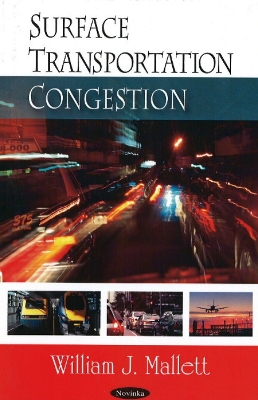Surface transportation congestion most likely will be a major issue for Congress as it considers reauthorisation of the Safe, Accountable, Flexible, Efficient Transportation Equity Act -- A Legacy for Users (SAFETEA), P.L. 109-59, which is set to expire on 30 September 2009. By many accounts, congestion on the nation's road and railroad networks, at seaports and airports, and on some major transit systems is a significant problem for many transportation users, especially commuters, freight shippers, and carriers. Indeed, some observers believe congestion has already reached crisis proportions. Others are less worried, believing congestion to be a minor impediment to mobility, the by-product of prosperity and accessibility in economically vibrant places, or the unfortunate consequence of over reliance on cars and trucks that causes more important problems such as air pollution and urban sprawl. Trends underlying the demand for freight and passenger travel -- population and economic growth, the urban and regional distribution of homes and businesses, and international trade -- suggest that pressures on the transportation system are likely to grow substantially over the next 30 years. Although transportation congestion continues to grow and intensify, the problem is still geographically concentrated in major metropolitan areas, at international trade gateways, and on some intercity trade routes. Because of this geographical concentration, most places and people in America are not directly affected by transportation congestion. Consequently, in recent federal law, Congress, for the most-part, has allowed states and localities to decide the relative importance of congestion mitigation vis-a-vis other transportation priorities. This has been accompanied by a sizeable boost in funding for public transit and a more moderate boost in funding for traffic reduction measures as part of a patchwork of relatively modest federally directed congestion programs. Congress may decide to continue with funding flexibility in its reauthorisation of the surface transportation programs. States and localities that suffer major transportation congestion would be free to devote federal and local resources to congestion mitigation if they wish. Similarly, congestion-free locales would be able to focus on other transportation-related problems, such as connectivity, system access, safety, and economic development. Alternatively, Congress may want to more clearly establish congestion abatement as a national policy objective, given its economic development impact, and take a less flexible and, in other ways, more aggressive approach to congestion mitigation. Three basic elements that Congress may consider are (1) the overall level of transportation spending, (2) the prioritization of transportation spending, and (3) congestion pricing and other alternative ways to ration transportation resources with limited government spending. Congress also may want to consider the advantages and disadvantages of specific transportation congestion remedies. Hence, this book discusses the three basic types of congestion remedies proposed by engineers and planners: adding new capacity, operating the existing capacity more efficiently, and managing demand.
- ISBN10 1604568852
- ISBN13 9781604568851
- Publish Date 1 October 2008
- Publish Status Unknown
- Publish Country US
- Imprint Nova Science Publishers Inc
- Format Paperback
- Pages 88
- Language English
